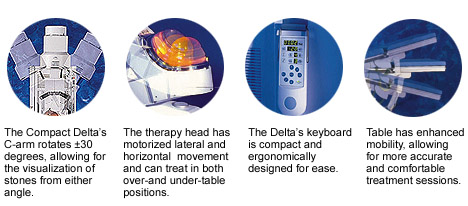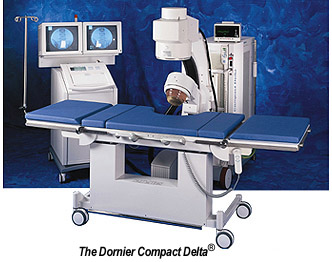|
UroTech is pleased to present lithotripsy by Dornier. Having pioneered
extracorporeal shock wave lithotripsy (ESWL) over 15 years ago,
Dornier is widely acknowledged as the global leader in shockwave
technology.
The UroTech / Dornier Lithotripsy Advantage
- Speed
— With a non-gaited 120 bpm, the Dornier lithotripter can
be up to 2 1/2 times faster than earlier, gaited models, with
an average treatment time of only 23 minutes.
- High-resolution
imaging — Better imaging means better treatment.
Advanced digital imaging and the best available fluoroscopic technology
facilitate visualization of stones with low radiopacity and improve
assessment of stone fragmentation.
-
OR
Location — Dornier's Compact Delta®
lithotripter is placed in your operating room, where it requires
little floor space. Providing equipment in a hospital or ambulatory
surgery center setting makes it very convenient. Peripheral
locations outside of the operating room suite are no longer
necessary.
- Design
— Dornier's U-frame table enables positioning options with
X-, Y- and Z-axis movement for enhanced comfort for patients and
clinicians. The C arm moves in two directions to shorten treatment
times and facilitate stone localization.

What are the
advantages of lithotripsy?
The main advantage of this treatment is that many patients may be
treated for kidney stones without surgery. As a result, complications,
hospital stays, cost and recovery time are reduced.
How successful is lithotripsy?
In those patients who are thought to be good candidates for this
treatment, about 70% to 90% are found to be free of stones within
three months of treatment. After treatment, some patients may still
have stone fragments that are too large to be passed. These can
be treated again if symptoms persist.
What can the patient expect after treatment?
After treatment is complete, the patient can move about almost at
once. Many people can fully resume daily activities within one to
two days. Some pain may occur when the fragments pass, which begins
soon after treatment and may last for up to four to eight weeks.
Oral pain medication is usually adequate to relieve symptoms.
Can
all kidney stone patients have this kind of treatment?
The size, number, location and composition of the stones are factors
that must be taken into account when exploring treatment options.
The stones must be clearly viewed by the x-ray monitor so the shock
waves can be targeted accurately. If anatomical abnormalities prevent
this, other methods of stone removal must be considered. Through
examination, x-ray and other tests, the doctor can decide whether
this is the best treatment for the patient. In some cases, extracorporeal
shock wave lithotripsy may be combined with other forms of treatment.

|





